Unlock your genetic potential or gift the power of personalized health. Browse our Supersaver Packs now.
10X Health System is a company in the health and wellness sector founded in 2021 by Grant Cardone, Brandon Dawson, and Gary Brecka. It aims to enhance performance and wellness by blending traditional and novel techniques. Its popular Superhuman Protocol utilizes magnetism, oxygen, and light to promote regeneration at the cell level. Gene testing, blood testing, and supplement services further boost its portfolio. This article offers an overview of 10X Health System’s principal services, products, and the feedback received from its clientele. It presents a balanced view of its approach to improving health outcomes and the diverse experiences of those engaged with its offerings.
10X Health System is a brand that aims to increase people’s wellness by enhancing human performance.
The company claims to redefine modern medicine with its Superhuman Protocol line.
According to the Superhuman Protocol, 3 pillars can help restore your healing power:
It offers a 5-part wellness approach that includes:
The company aims to promote optimal wellness, cellular repair, restoration, and regeneration.
10X’s health testing services are similar to those available at a clinic.
They detect health markers in your blood cell count, cholesterol, blood sugar levels, and more.
These biomarkers are indicators of your body’s health and can tell you what’s off.
10X studies these biomarkers to recommend solutions to guide you toward optimal wellness.
10X Health offers two genetic testing products:
*as of 15th October 2024
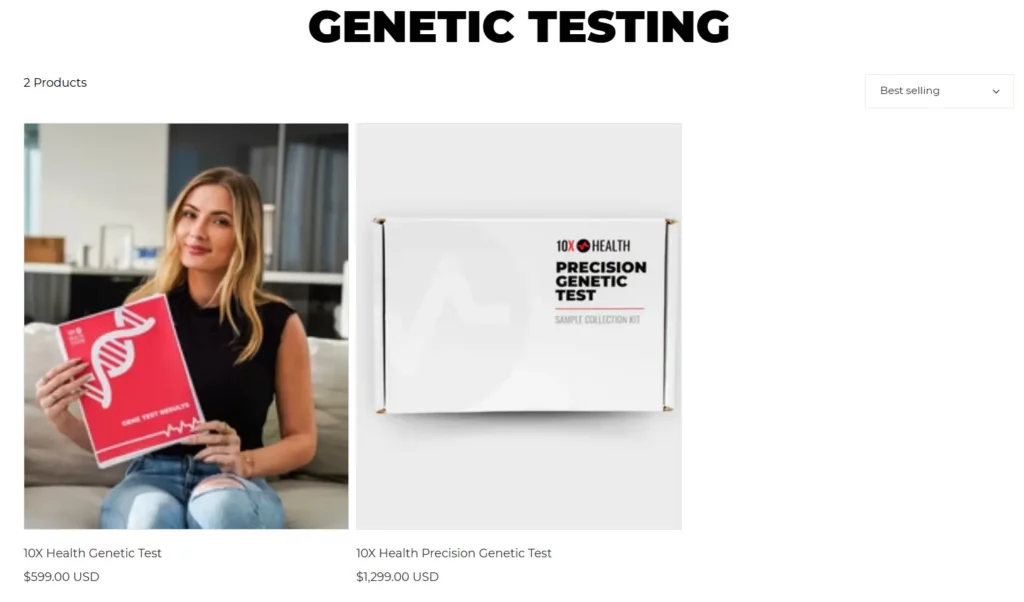
These tests provide a comprehensive snapshot of an individual's well-being by analyzing actionable genes and identifying areas for improvement.
You can optimize your health through personalized supplement protocols by understanding genetic deficiencies.
Here’s how 10X Health System’s genetic testing works:
The company sends you a kit and instructions on collecting the sample at home.
Once the company receives your DNA sample, its experts review the results and provide a detailed report and recommendations.
Personal advisors help you understand your current health status and offer supplements to help improve it.
The 10X Blood Test analyzes over 70 biomarkers to provide comprehensive and personalized reports.
Three main elements highlighted in the blood are nutrient deficiency, hormone optimization, and glucose control.
The process consists of three phases:
Here’s what you can expect from their report:
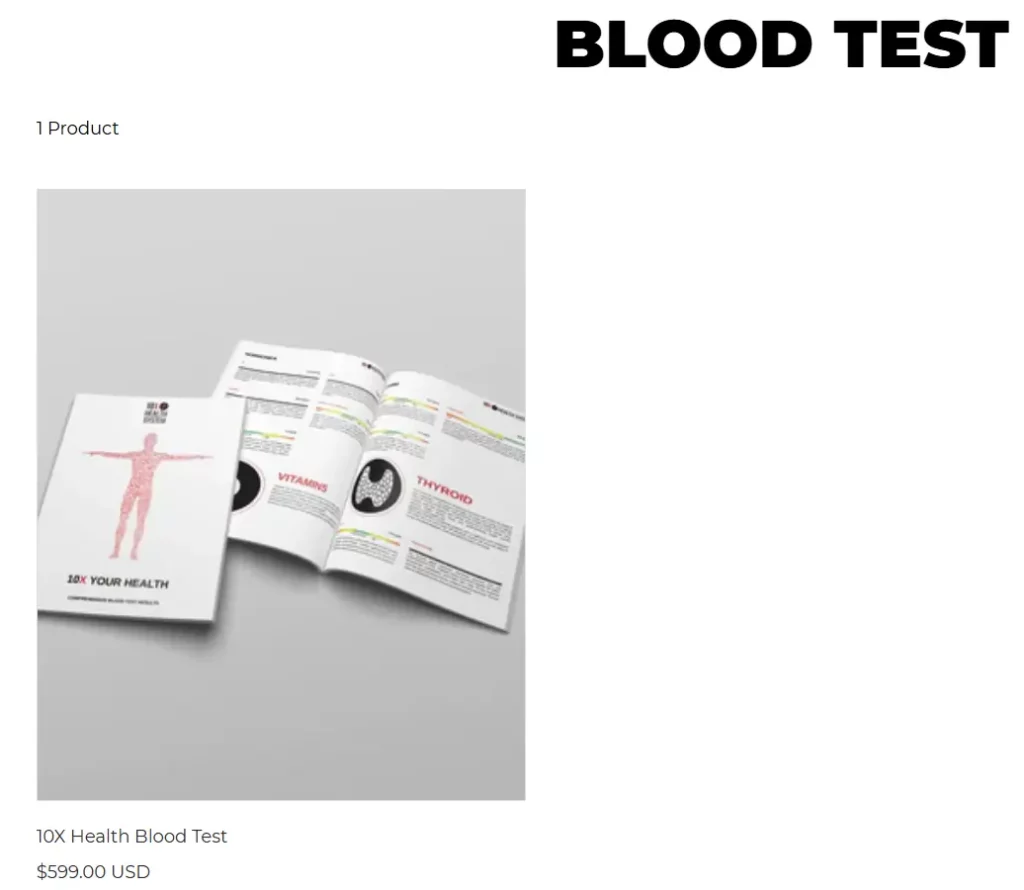
10X's IV services offer essential nutrient delivery, hydration, and immune boosts through customized IV drips.
These IV treatments promise benefits like
How It Works
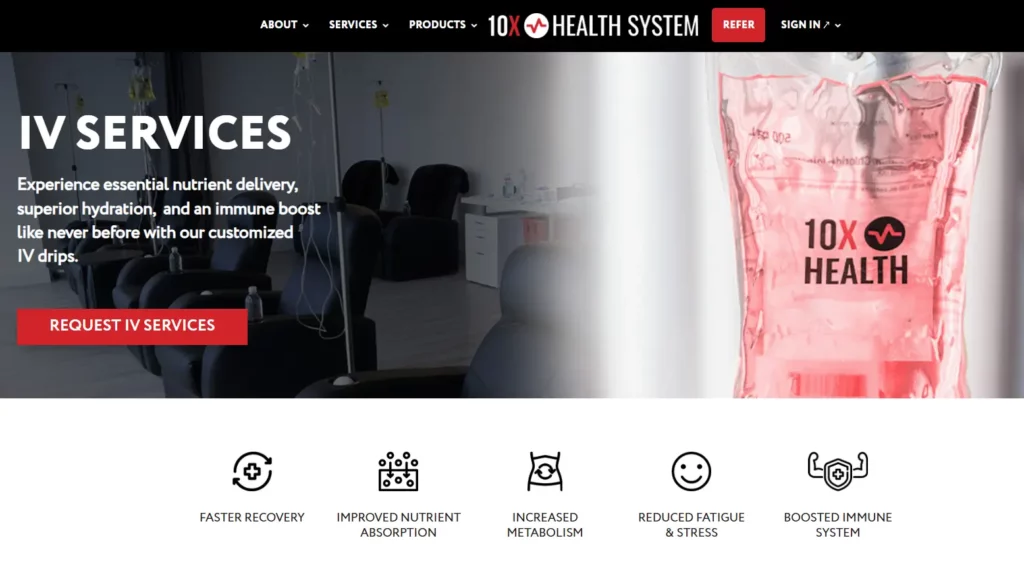
Besides the various testing services, 10X offers a wide range of products for customers who wish to upgrade their lifestyle and health.
10X's ultimate supplement protocol supports immune function, cognitive performance, cardiovascular health, mental clarity, and more.
They emphasize natural, high-quality ingredients to enhance overall well-being and vitality.
They offer over 10 different kinds of supplements targeted at different aspects of health:
| Supplement | Target |
| Daily Essential | Nutrition deficiencies and weight problems |
| REM-edy | Poor sleep |
| Cool. Calm. Collected. | Stress, anxiety, and blood pressure problems |
| 10X Brain Gains | Poor alertness, ADHD symptoms, and cognitive decline |
| Immuno-boost | Immunity, inflammation, and aging problems |
| Dynamic Duo | High-intensity lifestyles and blood sugar issues |
| 10X Probiotic | Unhealthy gut with bloating and indigestion |
| Magnesium | Muscle weakness, poor sleep, and anxiety |
| Zinc | Immune response, gut issues, and general healing |
| Alpha | Muscle strength and testosterone levels |
Some claimed benefits of the supplements include:
10X manufactures their supplements in FDA-compliant and GMP-certified facilities.
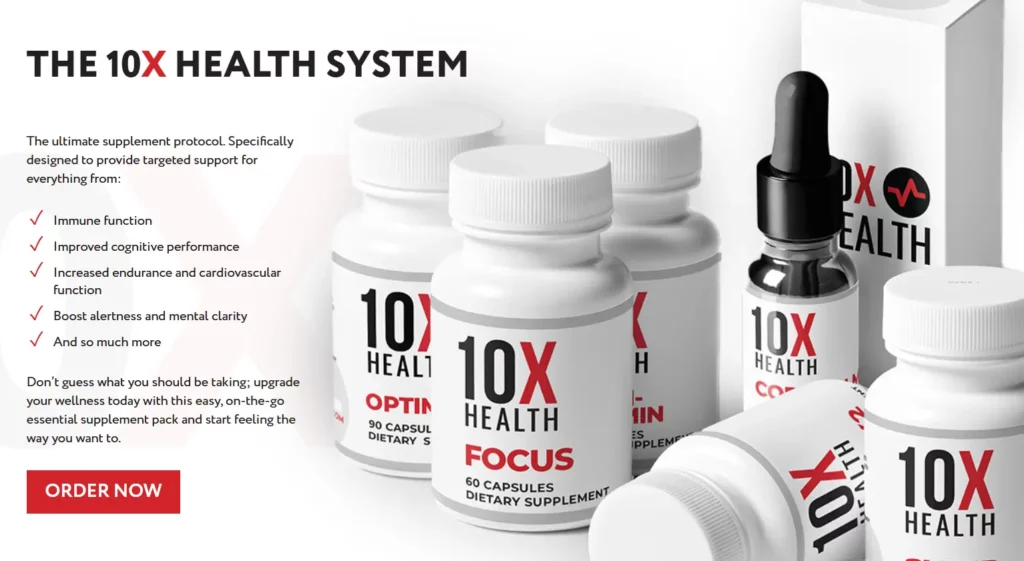
The Superhuman Protocol (SHP) offers a 3-step wellness program that utilizes magnetism, oxygen, and light to enhance the body's healing processes and overall well-being.
The Super Human Protocol of 10X Health Systems includes medical devices like:

The protocol offers a wide range of health benefits for the body, mind, and skin, such as:
The SHP bundle with the PEMF mat, EWOT Oxygen system, and the PBM Bed costs $133,561.
This figure doesn’t include the cost of setting up a 220-volt wall outlet for the Health Light Bed.
| Product/Service | Approximate Cost |
| Genetic Test | USD 599 and USD 1,299 |
| Blood Test | USD 599 |
| Health Supplements | USD 16 to USD 79 |
| SuperHuman Protocol Bundle | USD 133,561 |
| Merchandise | USD 18.50 to USD 180.99 |
These prices are accurate as of 15 October 2024 and are subject to change.
10X’s privacy policy mentions 11 kinds of data they collect from their users, including your name, age, email ID, approximate location, and sensitive health/genetic information.
This data helps them create a customer profile of you, which helps curate your experience on the site and the report’s content.
They may use this data for legal, targeted advertising, and commercial purposes.
Read 10X Health’s complete privacy policy here.
Reviews of 10X Health touch upon various aspects of its services, from positive to negative, depending on customer experiences.
On platforms like their website and Facebook, 10X Health has a rating of 4+/5, while most other review platforms average a 1-1.6/5 rating.
Below is a summary of the reviews and feedback found:
These ratings are as of 15 October 2024 and are subject to change.
In conclusion, 10X Health System offers advanced wellness services that some customers find beneficial for improving their health outcomes.
As with any health and wellness service, individual experiences and outcomes may vary, making it essential to weigh both the positive testimonials and the reported issues.
Users rate 10X Health products and services highly for their optimal health and performance benefits.
Here are some factors that contribute to the positive reviews of 10X Health:
However, the mixed/negative reviews regarding customer service, shipping delays, and perceived service value suggest that potential customers should carefully consider these aspects before opting for their services.
Gary Brecka recommends consuming 30 grams of protein within 30 minutes of starting your day, followed by 30 minutes of low-intensity exercise.
10X allows you to cancel your supplement subscription in two ways.
Log into their website and choose ‘Cancel Subscription’ or contact 10X’s customer service team at support@10xhealthsystem.com.
Several reputed companies offer personalized insights into your genetic data.
Xcode Life, 23andMe, AncestryDNA, FTDNA, and MyHeritage DNA are some such companies.
EmmaCare, Carium, Ciitizen, and GreenField Health are companies offering services in the health and wellness sector.
Have you ever felt a sudden pain in your upper right abdomen after a particularly stressful period? While many factors can contribute to the formation of gallstones, recent studies suggest that stress could be a potential culprit. This link between stress and gallstones raises critical questions about how our emotions impact physical health. In this article, we'll explore whether stress can cause gallstones, the mechanisms behind this relationship, and what you can do to reduce your risk.
Did You Know? You may carry certain gene changes that increase your risk for various chronic health conditions like diabetes, hypertension, and even gallstones! Learning about them can help you take actionable measures to reduce risk and possibly prevent these health conditions! Learn more:
Gallstones are hardened deposits typically made out of the digestive fluids that form in the gallbladder.
The gallbladder is a pear-shaped organ just below the liver, towards the right side of your abdomen.
The size of gallstones can range from as small as a grain of sand to as big as a golf ball.
The number of stones can also vary among different people.
The typical course of treatment is gallbladder removal or cholecystectomy. However, if someone doesn’t experience symptoms, they may not require surgery.
Gallstones often do not cause any symptoms, but when they do, they can range from mild to severe. Here are some of the common symptoms of gallstones:
Bile is the digestive fluid present inside the gallbladder. Gallstones are thought to occur when there’s a chemical imbalance in the bile.
However, the reason behind the chemical imbalance is still unclear.
Two things in the bile can contribute to gallstone formation.
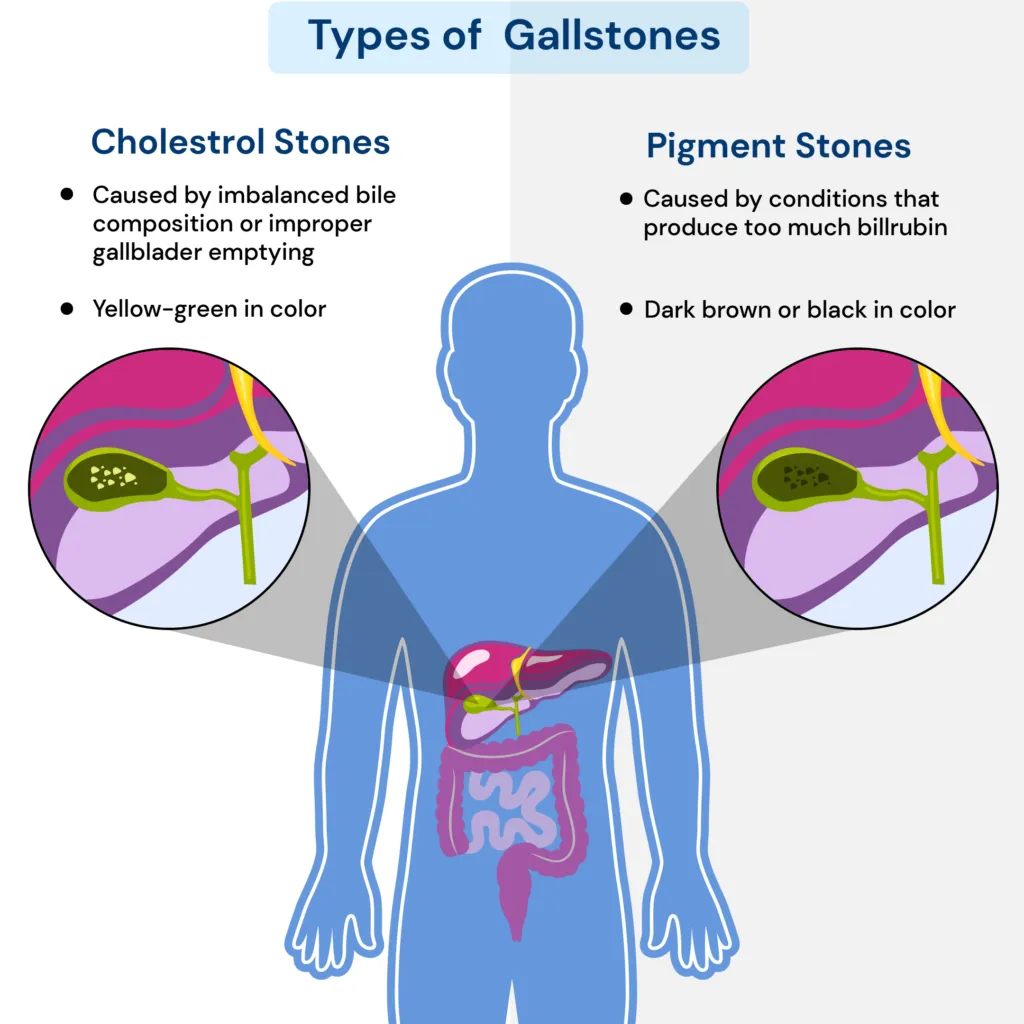
The following groups of people are more likely to get gallstones:
When the body is under stress, its energy is diverted from functions like digestion, so it can use all its resources to trigger the "fight-or-flight" response.
Digestion is slowed by lowering the contraction of digestive muscles and decreasing the secretion of digestive juices, like bile.
Chronic stress can result in repeated inhibition of bile release from the gallbladder, disrupting the entire biliary system.
This can increase the bile's cholesterol concentration, leading to gallstones.
Research shows diminished gallbladder emptying observed in patients with cholesterol gallstones.
Thus, chronic stress may lead to gallstone formation by affecting gallbladder emptying or bile secretion from the gallbladder.
While managing stress can help the body in numerous ways, it can particularly result in improved gut health and reduced risk of digestive troubles and gut-associated health conditions.
Here are some effective strategies to manage stress for improved gut health:
Overall, managing stress is essential for maintaining a healthy gut. Stress-reducing strategies and healthy lifestyle habits can promote better gut health and overall well-being.
Gallstones are caused when a chemical imbalance in bile (a digestive juice present in the gallbladder) causes it to crystallize and hardens, resulting in stone-like structures. Factors like a high-fat and high-cholesterol diet, a sedentary lifestyle, and obesity can contribute to gallstone formation. Uncontrolled stress can also result in gallstone formation by affecting gallbladder emptying. When the body is under stress, the energy from digestion goes toward fighting stress. So, digestive juices like bile are not released from the gallbladder. This can eventually lead to a build-up of bile juice with increased cholesterol concentration, leading to gallstone formation.
A grandparent DNA test delves into your heritage, offering scientific insights into your biological connections. By examining unique DNA markers inherited through generations, these tests reveal the strength of the grandparent-grandchild relationship. Whether seeking clarity for personal reasons or needing legal validation, grandparent DNA tests provide an accurate and reliable solution for uncovering familial bonds. Keep reading to understand your genetic inheritance clearly and gain insights into the strength of your ancestral connection with your grandparents.
Grandparent DNA tests are a scientific method for establishing biological relationships between grandparents and grandchildren.
They do this by analyzing specific sections of DNA, known as markers, that are inherited and passed down through generations.
Similar to genetic fingerprints, these markers can be compared to reveal if there is a match, indicating a biological link.
According to the established principles of Mendelian inheritance, an individual inherits approximately 25% of their DNA from each grandparent.
Parents contribute 50% of their genetic material to their offspring during reproduction. Therefore, your parents inherit 50% of their DNA from each grandparent.
Subsequently, they pass down another 50% of their DNA to you. This results in an average inheritance of 25% of your genetic makeup from each grandparent.
This pattern continues across generations, with you transmitting roughly 25% of your DNA to your children, who in turn will pass on a similar proportion to their offspring.
This predictable inheritance pattern ensures a relatively consistent distribution of ancestral DNA across generations.
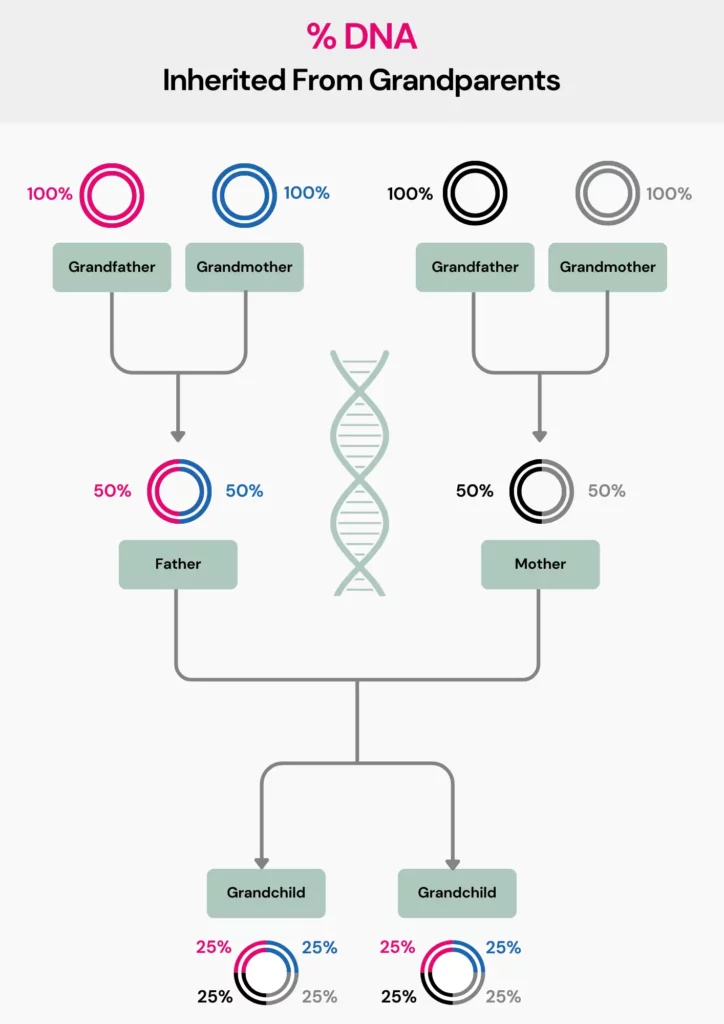
Grandparent DNA tests are generally very accurate, often providing definite results in many cases. However, there is a small possibility of obtaining an unclear result.
This can happen for a few reasons:
The chance of unclear results depends on who participates. If more relatives, like the child of the grandparent being tested, are involved, the test can be more precise.
For the most accurate DNA info, talk to a genetic counselor. They can give you current or up-to-date details and advice on testing.
The grandparent DNA test is performed using a test kit.
This DNA testing kit has easy-to-use mouth swabs that help collect a DNA sample from the individual.
The swab sample contains cells with the complete genetic information of the grandparent in the form of DNA.
Once the sample arrives at the laboratory, a polymerase chain reaction is performed to extract the DNA from the cells. This test amplifies the region of the cells that reveal DNA patterns.
This DNA pattern from the grandparents is then compared with that of the grandchild.
Based on this comparison, a statistical analysis is generated based on the match type. This is true for biologically related grandparent and grandchild pairs.
The analysis also gives a grandparentage index.
A legal grandparent DNA test is done for similar reasons as a legal paternity test, such as:
The DNA must be obtained from both grandparents on the biological father’s side. However, if one is unavailable, a single grandparent's DNA is acceptable.
These tests typically use buccal swabs for sample collection.
These swabs are simply cotton swabs gently rubbed on the inner cheek to collect cells.
Sometimes, you may also need to provide a blood sample.
A neutral, impartial third party usually collects the samples for a legal grandparent DNA test at a medical office, hospital, or health clinic.
The time taken to obtain the results of the grandparent DNA test depends upon the laboratory performing the test.
However, at the earliest, you can get your results in around three to five business days.
Upon order confirmation and payment receipt, a representative will arrange sample collection at a designated testing center within a vast network.
Due to the strictly maintained chain of custody, these results are legally permissible.
A grandparent DNA test is available as an at-home option.
The private at-home test kit is an option for those who wish to know if the grandparent and grandchild are biologically related before proceeding to the next step.
This test provides the same results as the legal grandparent DNA test. However, the results of this test cannot be produced for legal reasons.
At-home tests can be done with buccal swabs or saliva samples.
Once the sample is collected, you'll be required to send it back to your provider for testing.
At-home sample collection is easy and takes a few minutes. The results can take a few days to a few weeks.
Similar to legal tests, sample collection and analysis occur.
However, the results are invalid for court proceedings due to the absence of a controlled chain of custody.
Nonetheless, both legal and at-home tests tend to reveal the same genetic information.
| Legal Grandparent Test | At-home Grandparent Test | |
| Purpose | To establish biological relationships between grandparents and grandchildren | To establish biological relationship between grandparents and grandchildren |
| Legal admissibility | Admissible | Not admissible |
| Sample collection | Buccal swab or blood sample | Buccal swab or saliva sample |
| Turn-around time | Typically 3-5 days | A few days to a few weeks |
Grandchildren do not inherit DNA equally from all four grandparents.
A child’s DNA is usually shuffled between parents and grandparents by a process called recombination.
23andMe offers a new tool called the GrandTree that allows families to connect across three generations.
This tool connects grandparents and grandchildren.
23andMe’s GrandTree tool also offers a deeper insight into other relations like siblings, parents, and children.
You can now see what traits and ancestry you share with your blood relatives.
Families using 23andMe’s GrandTree tool can connect differently, bridging the gap in each generation.
Nearly 20% of adults over the age of 60 are vitamin B12 deficient. Vitamin B12 is synonymous with energy, focus, and overall well-being. While a healthy body relies on sufficient vitamin B12, food sources may be inadequate to meet the required amount. The most common treatment option for vitamin B12 deficiency is supplements. If accompanied by anemia, then injections. But did you know this essential nutrient primarily comes in two forms: methylcobalamin and cyanocobalamin? Although both effectively treat B12 deficiencies, their origins and properties differ markedly. This article looks at the specific attributes of methylcobalamin vs cyanocobalamin. We aim to help you understand methylcobalamin and cyanocobalamin by detailing their structures, absorption, benefits, and safety.
Methylcobalamin and cyanocobalamin are two widely used forms of vitamin B12, each with unique characteristics.
The former is a natural form of B12 and is directly active in the human body, whereas the latter is a synthetic form that the body can convert into active B12.
Despite structural differences, both forms effectively treat vitamin B12 deficiencies.
Concerns about the cyanide content in cyanocobalamin are unfounded, as the amount is minimal and considered safe by scientists.
Both forms share similar recommended intake levels and health benefits, although some researchers favor cyanocobalamin due to its stability and lower cost.
Both cyanocobalamin and methylcobalamin share a core structure:
The key difference lies in the molecule attached to the cobalt ion:
Both methylcobalamin and cyanocobalamin combat vitamin B12 deficiencies and offer additional health benefits:
Deficiency correction:
Neurological support:
Beyond addressing deficiencies, both methylcobalamin and cyanocobalamin offer promising support for nerve health.
Expert-recommended Read: Can Vitamin D And B12 Deficiency Occur Together?
Choosing the right B12 supplement depends on your needs. Here's a quick comparison of methylcobalamin (the natural form) and cyanocobalamin (the synthetic option):
Methylcobalamin and cyanocobalamin differ in their absorption and retention in the body. Research suggests varying levels of absorption between the two forms:
Overall, evidence suggests differences in absorption and retention between methylcobalamin and cyanocobalamin.
However, further research can help fully understand these dynamics, especially in diverse populations and under varying health conditions.
Research on people on a vegan diet has shown that cyanocobalamin and methylcobalamin are both helpful in addressing vitamin B12 deficiency.
According to the study, cyanocobalamin was more effective in maintaining healthy levels of serum vitamin B12 (called holotranscobalamin) than methylcobalamin.
There isn't a single "best" form of vitamin B12 for everyone. The two most common forms are cyanocobalamin and methylcobalamin.
Choosing the proper form depends on factors like:
Regarding safety, there's no clear winner between cyanocobalamin and methylcobalamin, the two most common forms of B12 supplements. Both are considered very safe for most people at recommended doses.
Cyanocobalamin contains a small amount of cyanide, but it is not considered to be harmful. Our body easily converts it into harmless compounds. Similarly, methylcobalamin hasn't shown any safety concerns at recommended intake levels.
Here are the two things that may be necessary for optimal safety:
Additionally, if you have any pre-existing health conditions, talk to your doctor before starting B12 supplements.
| Feature | Methylcobalamin | Cyanocobalamin |
| Type | Natural form, active in the body | Synthetic form, converted to active B12 |
| Source | Found in animal-based foods (meat, fish, eggs, dairy) | Synthetically produced, not naturally occurring |
| Cost | Generally more expensive | More stable and cost-effective |
| Absorption Rate | Approximately 44% of a 1-mcg dose absorbed | Approximately 49% of a 1-mcg dose absorbed |
| Retention | Better retained in the body | Higher excretion in urine, suggesting lower retention |
| Health Benefits | Effective for deficiency correction, neurological support, potential ALS treatment | Effective for deficiency correction, neurological support |
| Safety | Safe and naturally occurring | Contains minimal, safe levels of cyanide |
| Recommended For | People with absorption issues or specific medical conditions | Vegans and those seeking affordable options |
Vitamin B12 supplements are a good idea for people who struggle to get enough B12 from their diet. Here are some groups that might benefit:
Studies exploring daily methylcobalamin use in diabetic patients show promise. This natural form of B12 appears safe and may improve nerve pain (diabetic neuropathy) and heart health at doses of 500 mcg three times a day or 1,500 mcg daily.
The optimal B12 supplement (methylcobalamin or cyanocobalamin) depends on individual factors.
Absorption issues or certain medical conditions might favor methylcobalamin, the natural form.
Conversely, cyanocobalamin, the synthetic option, may be suitable for maintaining B12 levels in those with dietary restrictions.
Selecting the most appropriate form and dosage for individual needs requires considering overall health and dietary habits and consulting a healthcare professional.
https://www.healthline.com/nutrition/methylcobalamin-vs-cyanocobalamin
https://www.ncbi.nlm.nih.gov/pmc/articles/PMC8311243
https://www.sciencedirect.com/topics/medicine-and-dentistry/cyanocobalamin
https://www.healthline.com/nutrition/vitamin-b12-foods
https://www.ncbi.nlm.nih.gov/pmc/articles/PMC5130103
https://www.medicalnewstoday.com/articles/b12-and-crohns
https://www.ncbi.nlm.nih.gov/pmc/articles/PMC3257642
https://my.clevelandclinic.org/health/diseases/22377-pernicious-anemia
https://www.sciencedirect.com/topics/biochemistry-genetics-and-molecular-biology/methylcobalamin
Empathy is the ability of an individual to identify the intentions, feelings, thoughts, and desires of another individual and respond to them. Hence, it is considered to be vital for prosocial behavior and social cognition.
Recent research has reported how certain genetic variants contribute to our ability to empathize, suggesting that empathy is not solely a product of upbringing or social environment, but also has a heritable component.
This exploration raises important questions about how our genetic predispositions shape our emotional responses and interpersonal relationships, paving the way for deeper insights into the nature of empathy itself.
A large study was conducted by researchers from The University of Cambridge with considerable support from 23andMe researchers. Around 46,000 23andMe customers who consented to the study, completed an online survey which was used to evaluate their Empathy Quotient (EQ).
Here are five key findings from the study about empathy genes and their impact on health and well-being:
You may have always felt this, innately identifying a family that may seem more empathetic.
Now, a scientific study could back you up.
This study identified certain genetic variants that could contribute to empathy.
While the study did not identify all the genes associated with empathy, the identified variants were found to contribute to 11% variability.
Before this study, empathy was considered to be a factor that was learned or taught by the social situation that a child grew up in.
Instead, this study showed that there was a genetic factor associated with empathy.
So, how will finding out about your empathy genes help? Read on to find out.
Among the 46,861 23andme participants who were included in the study, 24,543 were females, while 22,318 were males.
When male and female samples were analyzed separately, females were found to have higher EQ than males.
However, a sex-stratified analysis did not provide a genetic association, indicating that non-genetic factors played a role in this difference.
This study showed that a low EQ score was associated with an increased risk of autism.
Multiple studies support this and have shown that when self-reported empathy was low, there was an increased risk of autism (Baron-Cohen et al., 2004 and 2014).
This could be due to a struggle to identify the thoughts and feelings of other individuals rather than problems in responding.
The sex-specific analysis showed that there was a significant genetic association between EQ and autism among men, than among women.
The study found a significant genetic association between EQ and schizophrenia.
Previous scientific studies have also shown that a reduction in cognitive empathy but healthy or stronger affective empathy was associated with schizophrenia.
The study results suggest that genetic variants that were associated with self-reported empathy had a moderately increased risk of schizophrenia.
This 23andme study also showed that genetic variants for self-reported empathy were associated with a slight increase in the risk for anorexia nervosa.
An earlier study (Warrier et al., 2017) also showed a genetic association between cognitive empathy and anorexia nervosa.
Further, the current study showed that there was a significant genetic association between EQ in females and anorexia.
In <24 hours, you'll have the report(s) delivered to your email inbox!
Xcode Life's Traits and Personality Report is about self-empowerment through self-awareness.
For example, people with a higher genetic score for angry temperament can take measures to actively prevent angry outbursts, once they understand that this tendency is innate.
Most people are usually aware of their innate instincts.
However, a personality genetic report can reveal several such aspects that people are generally unaware.
Xcode Life's Trait and Personality Report provides information on extraversionness, intelligence, entrepreneurship potential, and more than 25 such traits. You can find out more about it here.
MTHFR stands for methylenetetrahydrofolate reductase, the infamous enzyme whose incorrect shape can put you at risk for a long list of conditions.
MTHFR is a very important enzyme that converts folate into a more usable form called methylfolate in each cell of the body. Methylfolate is responsible for the production of two important compounds.
First is a class of biochemicals called neurotransmitters. They are a class of chemicals that help you think, emote, and perform all sorts of physical activities.
Non-functional MTHFR enzyme that results from single nucleotide changes in your DNA will lead to low levels of neurotransmitters that, in turn, have consequences like insomnia, anxiety, depression, and ADHD, among others.
The second important compound that methylfolate helps to make is called S-adenosylmethionine (SAMe).
SAMe helps to regulate more than 200 enzymes in the body.
Without SAMe, your body is predisposed to conditions like infertility, thrombosis, miscarriage, autism, and certain forms of cancer.
An MTHFR genetic test does not require a medical recommendation.
You can simply download your raw DNA data and upload it to a third-party service provider to get your results.
Genetic reports are generated after the analysis of different polymorphisms in the MTHFR gene.
These polymorphisms tell you which variants you carry and if you are homozygous or heterozygous for those variations.
Now that you know the importance of being aware of your MTHFR polymorphisms, let’s compare two popular tools that provide you with your MTHFR status. These two third-party tools provide a comprehensive MTHFR status report from your raw data from companies like 23andme, AncestryDNA, Family Tree DNA (FTDNA), and others.
Genetic Genie test is a DNA raw data analysis from a 23andme ancestry test. The results are free.
The website interprets your DNA raw data for only your methylation and detox profile.
The detox profile looks at gene SNPs of the cytochrome P450 detox enzymes, amongst others.
It is important to look at this specific information because certain genetic polymorphisms have been shown to impair the detoxification of drugs, hormones, environmental toxins, xenobiotics, and more.
The results column indicates whether you have a favorable, unfavorable, or intermediate genotype.
Your result is not determined solely by any single entry but by the cumulative effect of all the genes and variations listed.
Image showing a section of the methylation report from Genetic Genie
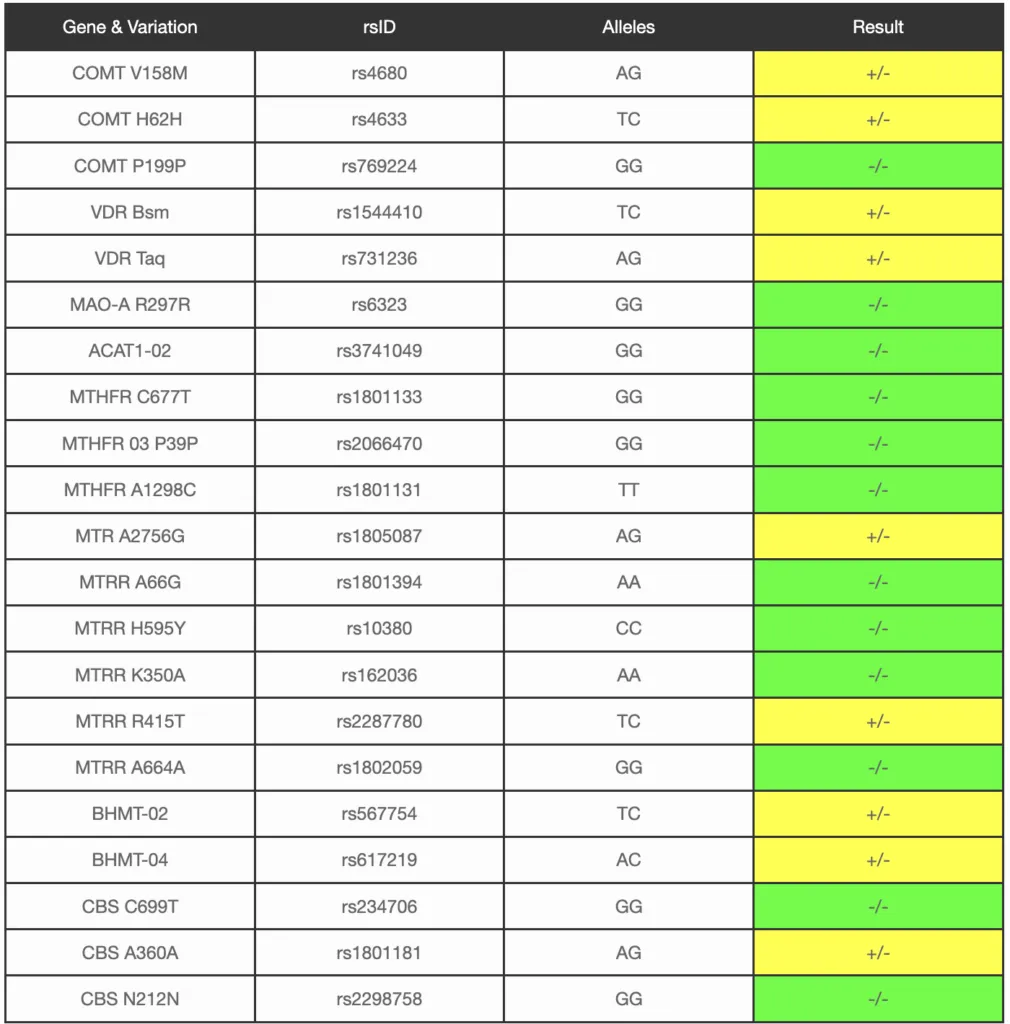
To use Genetic Genie, you need to download your raw data file from the 23andMe website and upload it to the website.
Before you upload to the tool to test your MTHFR status, it is advisable to go through the website's privacy policy.
If you want to see a sample of how the test results look, you can download the dummy raw data file available on the website and upload it immediately.
According to the website, the DNA you upload for the free report is not stored anywhere. Further, the data is encrypted with an HTTPS connection.
So, there's little to no risk of DNA data misuse, making Genetic Genie a very safe platform.
However, it is recommended that you read their privacy policy in detail before using their services.
Xcode Life test results are expert-curated from several large and high scientific authority databases, including UK biobank, Clinvar, OMIM, SNPedia, and leading scientific journals, to name a few, to curate the variant annotations.
Once you upload your raw data to Xcode Life, you will get your test results within 24 hours. You can download your test results and take it to your next routine health test check-up.
Images showing snippets of the MTHFR and Methylation report from Xcode Life
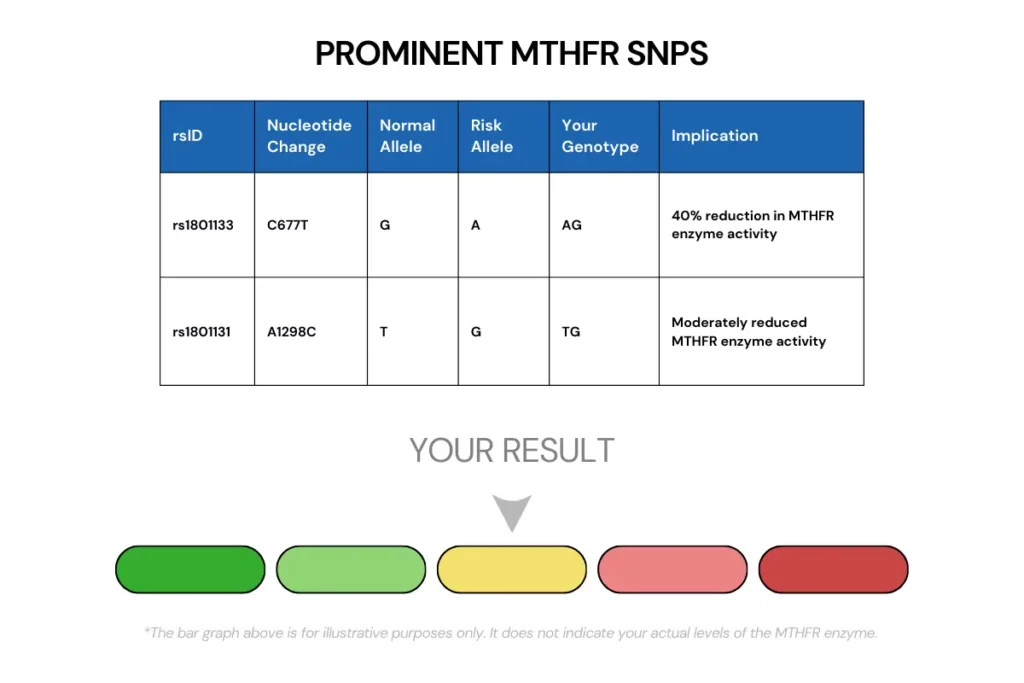
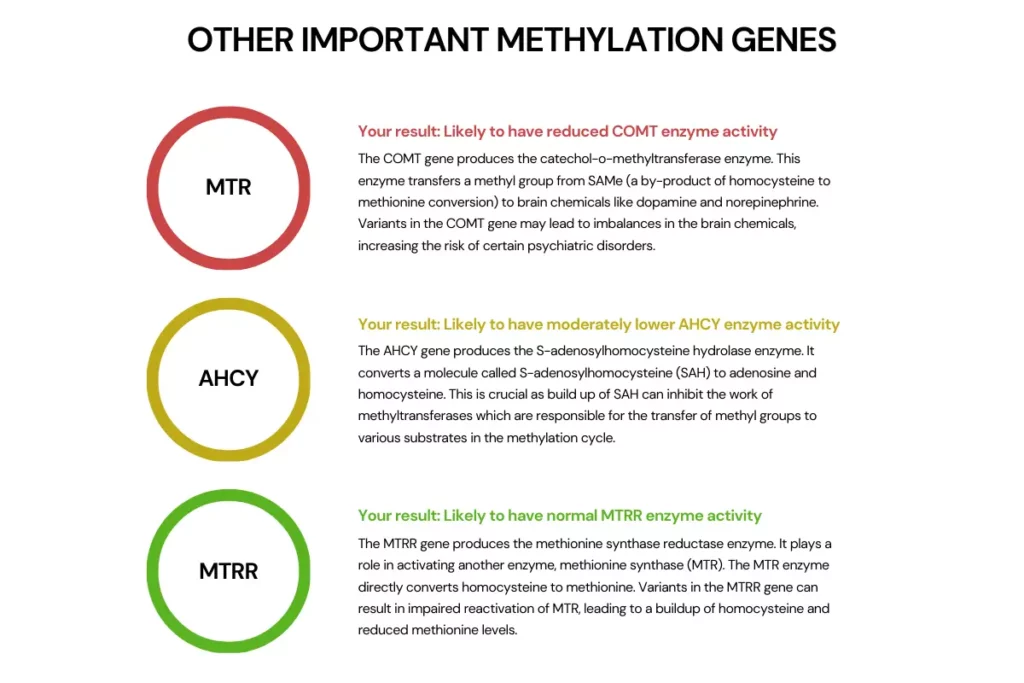
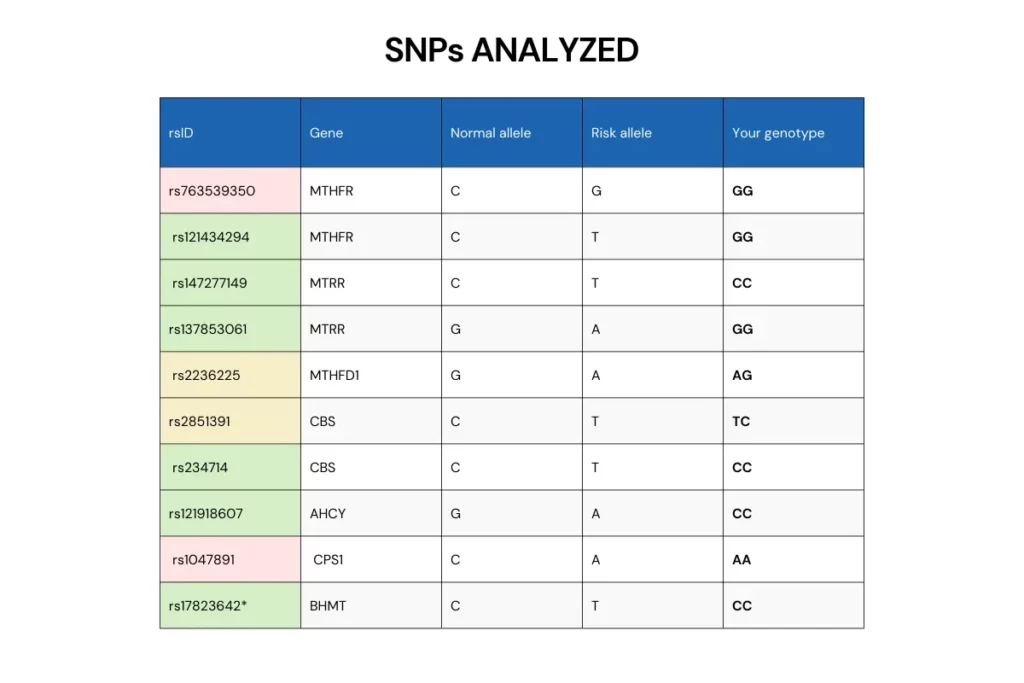
Xcode’s MTHFR reports are easily readable, understandable, and implementable.
The core philosophy of Xcode reports is to empower the user with actionable genetic information that they can use to enhance health and well-being.
The report not only includes a number of genetic variants in the MTHFR, MTRR, MTHFD, and other genes but also detailed and practical recommendations on compensating for MTHFR deficiency.
| Xcode Life | Genetic Genie | |
| No. of variants analyzed | 64 | 21 |
| No. of genes analyzed | 15 | 9 |
| Results interpretation | Provided | Not provided |
| Bar graph result representation | Present | Not present |
| Recommendations | Included | Not included |
| Post-test one-on-one chat assistance | Available on request | Not available |
| Price | $30 | Free |